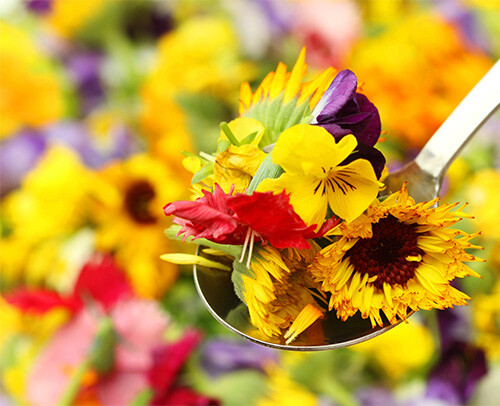
Unless you’re auditioning for the new seasons of Survivor, Fear Factor or So You Think You Can Digest That, there is no reason to ever attempt eating a flower.
Although there are quite a few flowers that can be digested safely, there would seem to be no reason to try it, as there are many other nourishing options available (food, for example).
Nevertheless, for those who like to try everything once, the following flowers can (though probably shouldn’t) be eaten.
1. Anise Hyssop
A member of the mint family, Anise Hyssop can not only be used as a spice or as part of a tea leaf blend, but it can also be eaten whole.
While anise is recognized as the flavor in black licorice, anise extract is actually used in lots of recipes, from pound cakes to liqueur. While these flavors are more subdued, taking a mouthful of anise hyssop is a much more intense experience, and therefore should not be attempted by anyone who hates Jagermeister, or loves their functioning taste buds. Although eating this plant is safe, that does not imply it is enjoyable.
2. Carnations
“You’re gonna love it in an instant” …or salad.
Otherwise known as the “poor man’s rose,” the carnation had many uses over the years; hair decoration, 8th grade Valentine’s Day present, lapel decoration for hit men, etc. However, eating the flower gives new meaning to “Carnation Instant Breakfast.”
Although carnations seem sweet and light, they actually taste quite peppery and clove-like. While young men should still send chocolates to their prospective lovers, it is nice to know that if the budget is tight and the recipient likes tacos, a carnation can easily serve as both a romantic gesture as well as a spicy treat.
3. Chamomile
Tea tastes better when brewed in your mouth.
While the petals are the only part of the chamomile plant that are edible, they are also the main ingredient in chamomile tea. This means that for anyone who loves a hot mug of chamomile but just can’t wait the 60 seconds it takes to microwave water, eating chamomile straight off the vine is the way to go.
Nature’s equivalent to drinking Pepsi syrup directly from the back of the soda fountain, eating chamomile leaves is the perfect snack for those looking to enjoy the relaxing taste of tea in the same way a cocaine addict would. By rubbing the leaves on your gums, you can ensure that you enjoy the entire chamomile experience without the embarrassment of having to ask anyone for a cup of hot water.
4. Dandelion
Another “petals-only” flower, the dandelion is remarkably high in vitamins and minerals. Rocking insanely high amounts of Vitamins A, C, K & H as well as beta carotene, lutein and fiber, a dandelion could be an important part of a balanced diet, if it wasn’t for the fact that it was a dandelion.
While I’m sure that cats are high in protein and knives are high in iron, that doesn’t mean that eating them becomes logical. (Although dandelion wine is popular, that is an entirely different story; once a bizarre food becomes alcoholic, it is safe for ingestion again.) Those looking to supplement their diet with vitamins should try taking vitamins. Everyone else should try not eating the weeds out of their front lawns.
5. Lilac
Shoe bottoms + lemonade = the taste of lilac.
Popular in gardens and floral arrangements, lilacs are also popular in the lunch boxes of weirdoes. Exuding the taste of lemon with just the slightest hint of dirt, a lilac can be just the thing for those looking for a snack in the middle of the day (or forest).
While far more people grow lilacs than eat them, the fact remains that they are a popular dish in the plant-eating community. Although lilacs are a part of the olive family, it is important to view them as the distant cousin that may be adopted, and not a younger sibling who tastes just as good on pizza.
6. Roses
Avoid eating the thorns.
A favorite of florists, romantics, and college football fans, the rose has long been the dominant member of the flower community. There is no more elegant way of saying “I love you,” “I miss you” or “I’m hungry” than with a rose.
Apparently, the rose tastes as good as it smells, as there are a large number of recipes featuring rose hips as a primary ingredient, including rose candy, jelly and soup. While it’s probably best not to sink your teeth into anything delivered by a florist (as roses can occasionally be treated with preservatives to make them stay pretty), anything found growing in the ground is fair game.
7. Sunflower
Sunflowers are neither the sun, nor flowers.
While sunflower seeds have been a staple amongst baseball players and farmers for generations, the petals of sunflowers can also be eaten (though they have yet to be released in ranch flavor).
Sunflower seeds, oil, and petals can all be used in recipes, including breads, pasta, and cookies. While many of these recipes require special processing of the plant, impatient hobos everywhere can rest easy knowing they can pluck and eat the yellow petals right off the vine. While the taste is somewhat bitter, eating this plant remains perfectly safe.
Though there are many who would be reluctant to try them, all of the aforementioned plants are safe for eating. Whether you are simply trying to get in tune with nature or are an escaped fugitive on the run from the feds, eating flowers could be a new (and certainly interesting) option for those looking for different meal options.